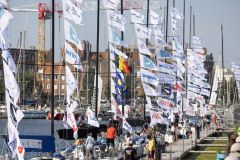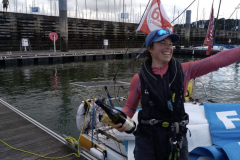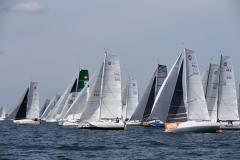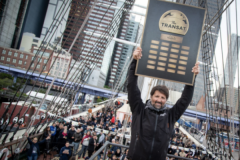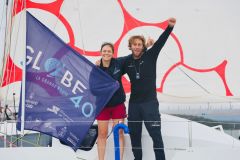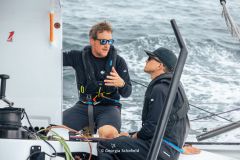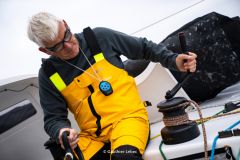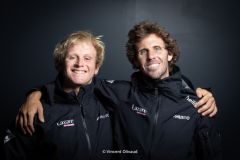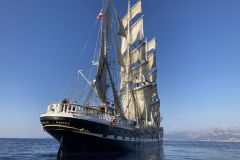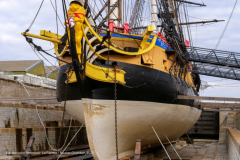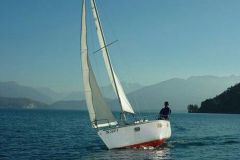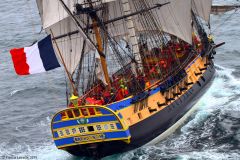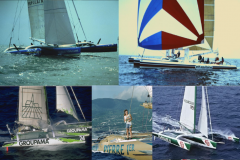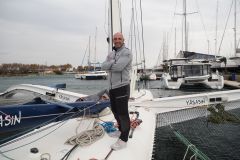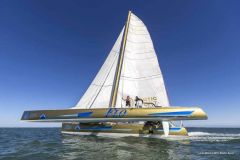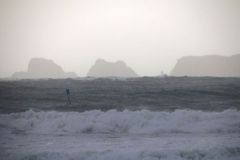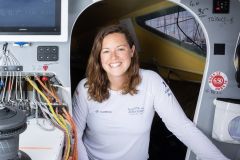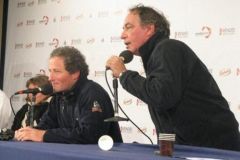A taste for adventure from an early age
Born on September 16, 1943 in Clamecy, Nièvre, Alain Colas was raised by his father, a renowned earthenware craftsman, and dreamed of adventure and escapism with his nose in his books. The man who " always knew it was important to make your dreams come true "is a studious student with a taste for the literary world. He imagined himself as an adventurer, following in the footsteps of his maternal grandfather, a great traveler. In 1961, he passed his baccalauréat and went on to study literature and English at university.
It was in 1963 that he discovered the pleasures of sailing a kayak. He knew nothing about boat building, and went on to learn at a boatyard, building the kayaks of his future canoe club. Today, the club bears the late navigator's name.
In 1965, he applied for a lectureship at the University of Sydney in Australia. When he didn't get the job, he left for the other side of the world on a cargo ship in 1966. While there, he managed to secure a position at Sydney's Faculty of Arts, and at the age of 22 became a lecturer at St-John's College, where he taught French literature. This is how he discovered sailing and ocean racing on Sydney Harbour.
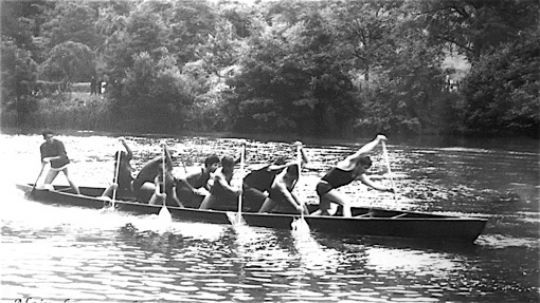
Discovering ocean racing
In 1967, he met Éric Tabarly, who was competing in the Sydney-Hobart, a 630-mile race from Sydney to Hobart. Tabarly offered to take him aboard Pen Duick III to New Caledonia. Accompanied by Eric's faithful sidekick Olivier de Kersauson, the three men were caught up in a tropical cyclone that sent them drifting towards a coral reef. Although they were reported missing, the three men escaped unharmed. A year later, obsessed with sailing, he decides to join Tabarly in Lorient, as he prepares for his solo transatlantic race. He builds a giant experimental multihull, Pen Duick IV . From 1968 to 1969, Alain Colas took part in the racing season alongside Tabarly in order to familiarize himself with the profession of sailor, and at the same time became a marine journalist with Olivier de Kersauson, who took the photos. In 1970, he bought Pen Duick IV to Tabarly, recounting his travels and selling photos to pay the first instalments.
To get to know his boat better, he took part in the Sydney-Hobart race, then sailed to Tahiti to write reports on Polynesia. While there, he prepared his Pen Duick for his return to France, and met his partner in 1971, who would go on to give him three children.
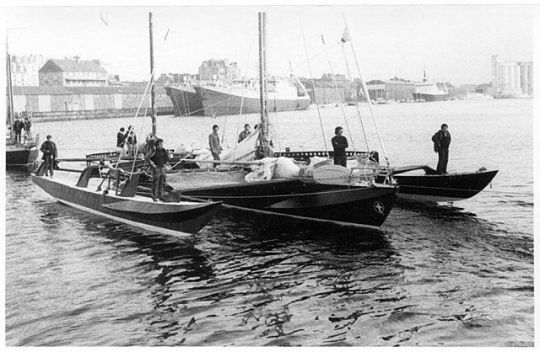
A sailor, adventurer and reporter
On June 17, 1972, he took part in the fourth Transat, a single-handed race from Plymouth to Newport aboard Pen Duick IV. He reached the United States in 20 days, 13 hours and 15 minutes, a new record (25 days, 20 hours, 33 meters by Sir Thomas Lipton in 1968) that made him a hero. Éric Tabarly, his mentor, had also taken part in the Transat, winning the 2 ème edition.
He then set out to complete the first single-handed round-the-world voyage in a multihull aboard Pen Duick IV, renamed Manureva the Tahitian word for "bird of travel" was slightly adapted to cope with the seas of the southern hemisphere. He set sail from Saint-Malo on his multihull on September 8, 1973. He made a stopover in Sydney and rounded Cape Horn on February 3, 1974. On March 28, 1974, he returned to Saint-Malo, beating Sir Francis Chichester's single-handed round-the-world monohull record by 32 days.
At the same time, a crewed round-the-world monohull race was held for the first time, the Whitbread, in which Tabarly took part. Alain was criticized for trying to attract media coverage for the Whitbread, without actually taking part. It was also this race that put an end to the two men's friendship, with Alain Colas enjoying the public's favor and Eric Tabarly, criticized, having to retire.
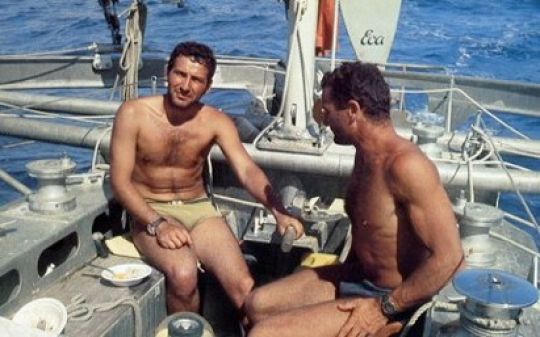
Building Club Méditerranée
In 1975, Alain Colas embarked on the construction of a 72-meter-long, four-masted sailing yacht, the Club Méditerranée a state-of-the-art facility. She used wind, water and solar power, and was equipped with a satellite positioning system, a computer and a fax machine. He hoped to complete the 1976 solo Transatlantic race aboard her. But on May 19, 1975, he had an accident! The navigator's right ankle was severed by an anchor rope on Manureva. He underwent 22 operations to save his foot. Nevertheless, he supervised the construction of his four-master from the hospital in Nantes. On February 15, 1976, the boat was launched at the Mourillon arsenal in Toulon, and made her maiden voyage on March 21, 1976.
On June 5, 1976, Alain Colas set off from Plymouth on the fifth single-handed British Transat. The race is swept away by storms in the North Atlantic, sinking five boats. Club Méditerranée the halyards broke one after the other. He decided to make a technical stopover, arrived and received a 58-hour penalty, the committee reproaching him for helping crew members hoist his sails during his stopover. He was demoted to 5th place e place.
After the race, he represents France on Club Méditerranée in the Hudson River ships' parade for the U.S. bicentennial. Returning to France in 1976, he organized "Bienvenue à bord" (Welcome aboard), tours and sailings aboard his four-masted ship, which proved a great success.
In 1980, Bernard Tapie bought Club Méditerranée which will become Phocéa .
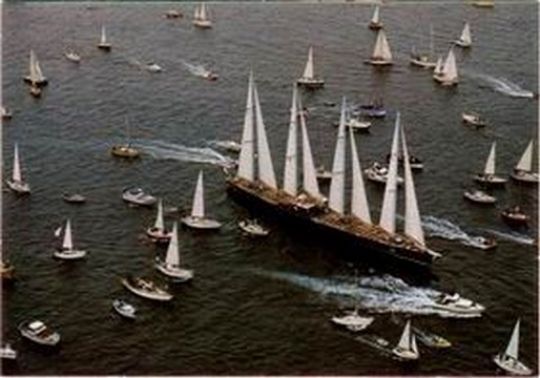
A final race that will make him a legend
In 1978, Alain Colas took part in his last race, setting off from Saint-Malo on November 5 for the first edition of the Route du Rhum. " The boat is running perfectly, and I'm back in touch with Manureva... I'm steering him more gently than before, and I think he appreciates it... Manureva and I are making good progress... Greetings to the whole team." As he passed the Azores, off the coast of Portugal, he sent his last radio message on November 16, 1978 I'm in the eye of the storm. There's no sky anymore; everything is an amalgam of elements, there are mountains of water around me". While leading the race, he was buried by a storm and never came out... He died on this sad day, at the age of 35. At the time, multihulls were not unsinkable. Numerous searches were carried out, but neither the sailor nor the boat were ever found.
Many tributes
In 1979, Serge Gainsbourg wrote a song in tribute to the departed sailor, the famous "Manureva", which was composed and sung by Alain Chamfort. When the family heard it on the radio, it was a heartbreaker, but after all, it also helped preserve the myth of Alain Colas and his famous "oiseau du voyage". Several streets, buildings and places now bear the name of Alain Colas.
Photo credit : alain-colas.com

 /
/ 






